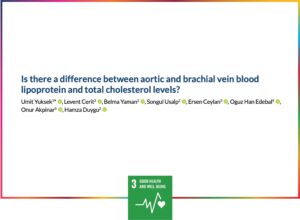
Researchers from Near East University have collaborated on a study shedding light on the disparities in lipid levels between aortic and venous blood samples, uncovering potential implications for cardiovascular health. The study, aiming to understand the mechanisms behind atherosclerosis primarily affecting arteries rather than veins, involved 125 patients aged 18 and above.
The participants, with a mean age of 62 years, underwent blood sample collection from the proximal ascending aorta and brachial vein after an overnight fast. Strikingly, the results demonstrated significant differences in lipid profiles between aortic and venous samples. Of the participants, 82% were diagnosed with coronary artery disease through coronary angiography, emphasizing the relevance of the findings to cardiovascular health.
Noteworthy gender distribution revealed that 64% of the participants were males, and 36% were females. Additionally, 31% of the patients were undergoing statin treatment, highlighting the clinical relevance of the study in the context of lipid management.
The key findings indicated that mean arterial total cholesterol (LDL), HDL, and triglyceride levels were significantly lower than their venous counterparts. Aortic total cholesterol levels measured 187.3±45.3 mg/dL compared to 204.5±52.6 mg/dL in venous samples (p<0.001). Similarly, LDL levels were 116.7±41.5 mg/dL in arterial blood versus 128±45 mg/dL in venous blood (p<0.001). HDL and triglyceride levels also displayed significant differences, emphasizing the unique lipid environment in arterial circulation.
In the context of Sustainable Development Goal 3 (SDG 3) – Ensure healthy lives and promote well-being for all at all ages, this research contributes valuable insights into cardiovascular health. Understanding the distinctive lipid composition in arteries could pave the way for targeted interventions and personalized treatment strategies to mitigate the risk of atherosclerosis and associated cardiovascular diseases.
In conclusion, this collaborative study not only elucidates the lipid variations between aortic and venous blood but also underscores the potential clinical implications for cardiovascular health, aligning with the global efforts to achieve SDG 3 by advancing our understanding of preventive and therapeutic approaches in the realm of cardiovascular diseases.
More Information:
https://www.scielo.br/j/ramb/a/dYNkmJwkgPx3zpT8PQrVCjJ/?format=pdf&lang=en